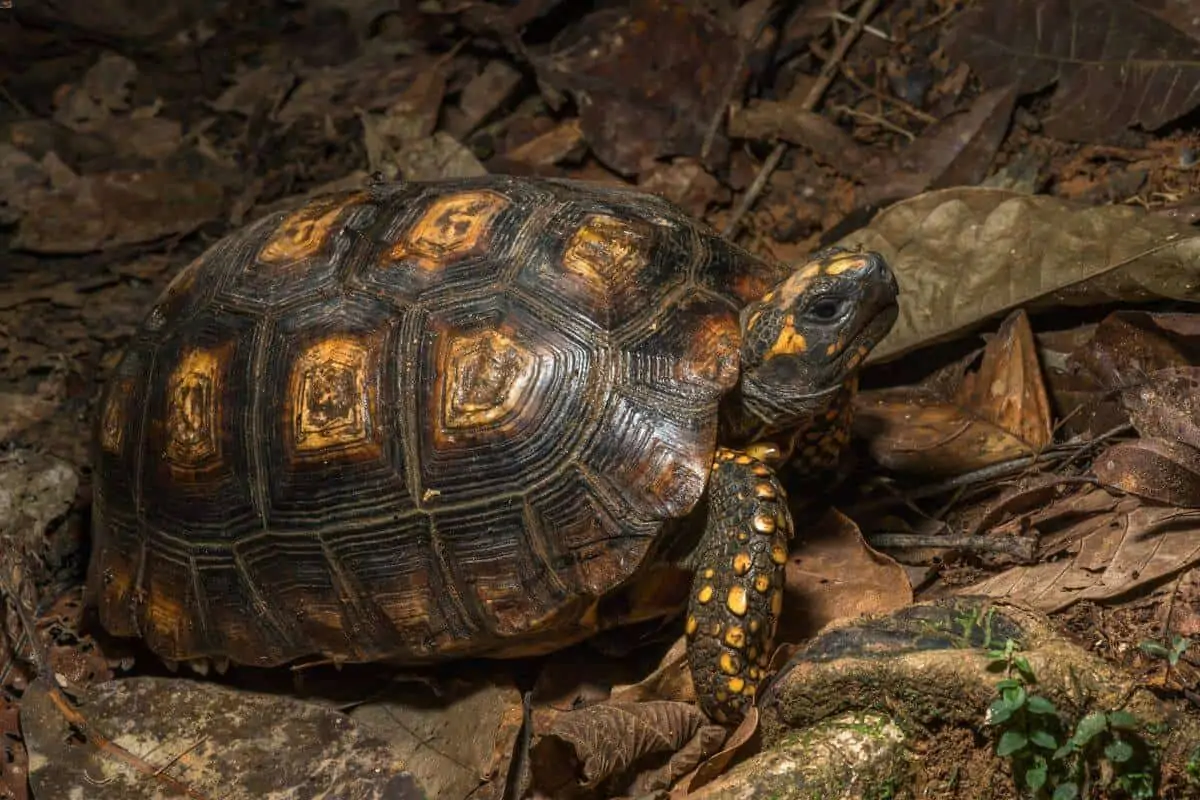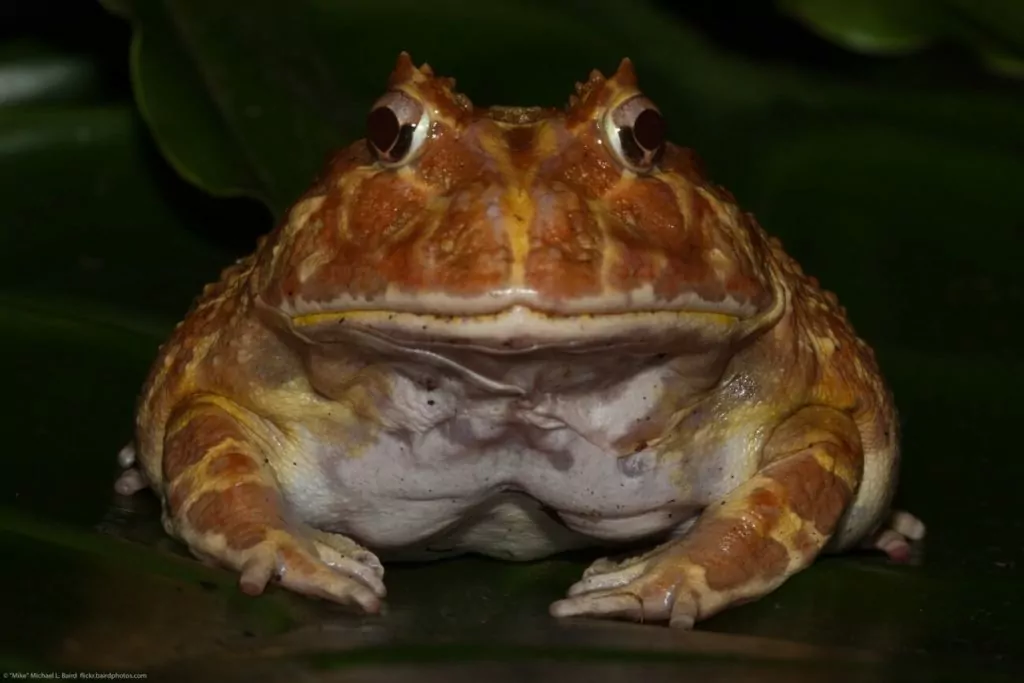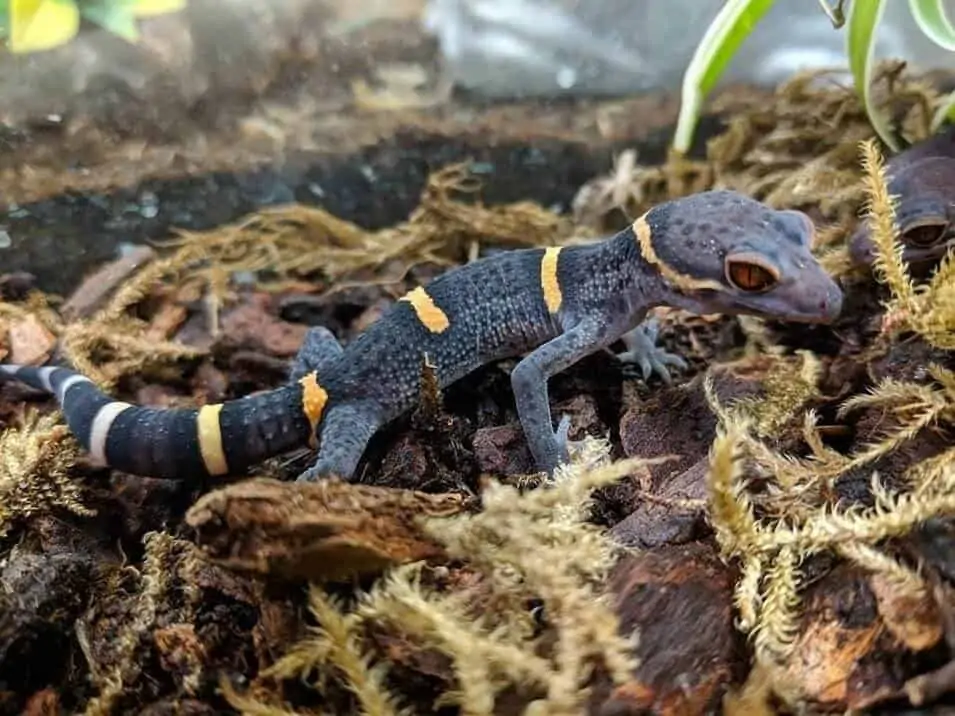The yellow-footed tortoise is a large and beautiful species that can be very fun and rewarding pets to keep. They have a long lifespan and some unique qualities that really make them stand out!
But these tortoises are not the easiest reptiles to own. Their size and condition requirements make them a bit tricky at times.
This guide will cover the fundamentals of yellow-footed tortoise care for anyone who is interested in getting one as a pet.
Let’s get started!
Table of Contents
Species Summary
The yellow-footed tortoise (Geochelone denticulata) is a gorgeous reptile species that can live for several decades. Closely related to the red-footed tortoise, these reptiles can be slightly more challenging to care for.
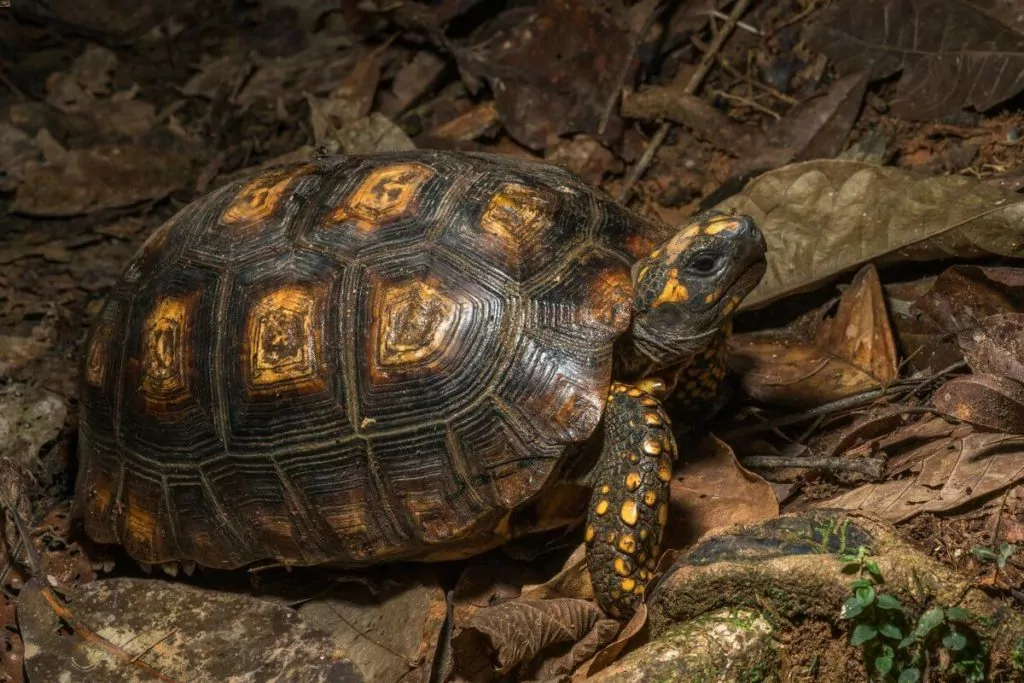
This can be surprising to some people since they assume that most pet tortoises are very low-maintenance reptiles to care for. However, this species requires more stable temperatures and a nutrient-rich diet to stay healthy.
This species is the largest in mainland South America. Typically, they inhabit humid rainforests throughout Southern Colombia down to Bolivia. With that being said, they can also live in grasslands and savannahs. More often than not, they stick close to the water in the wild.
A slow-moving and docile creature, yellow-footed tortoises can do quite well in captivity. However, you need to provide the necessities in order for this to happen!
Appearance & Colors
It’s easy to mistake the yellow-footed tortoise for its red-footed counterpart at first glance. They are both large reptiles with gorgeous shells! However, yellow-footed tortoises are distinct in their own right.
Their massive shells, while still oval in shape, tend to be wider and more rounded. The carapace is usually yellowish-brown with shades of dark brown on the edges of individual scutes.
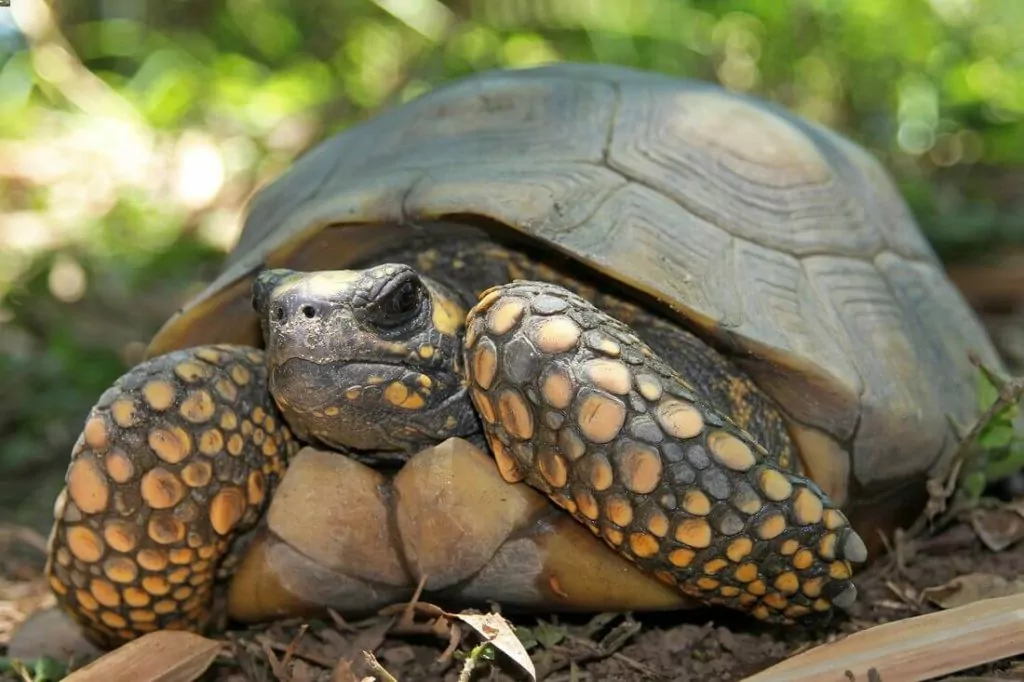
Like other tortoise shells, the scutes are ridged and feature a raised center in pale yellow, orange, or light brown.
The skin is dark brown or black. Brighter markings of yellow accent the head. Meanwhile, the limbs and tail feature bright yellow scales, hence their name!
The head is longer than it is wide. These tortoises also have an upper jaw with three points, which makes them easier to identify.
The forearms are sporting five claws. However, the hind legs are flatter, resembling the legs of an elephant.
Expert Tip: Sexual differences are subtle. Males often have sides that curve inward, creating a defined waist. Male tortoises also have a muscular, side-carried tail while females have a short conical one.
Yellow-Footed Tortoise Size
Make no mistake: these reptiles are rather large! The average size of an adult yellow-footed tortoise is about 14 inches.
However, this can vary dramatically.
Some will never make it past 14 inches. On the other hand, others will grow beyond that average to reach lengths of 24 to 28 inches!
Expert Tip: The biggest yellow-footed tortoise ever recorded was 37 inches long!
Generally, males are bigger than females. But interestingly enough, outliers that grow beyond the average tends to occur more with females.
Lifespan
These reptiles are quite the long term commitment. With the right care, yellow-footed tortoises can have a lifespan that exceeds 50 years!
Of course, there’s no way to guarantee life expectancy. Like any other captive animal, poor husbandry can lead to disease and an early death. The best thing you can do is make sure you purchase your pet from a trustworthy seller and provide the best care possible.
Yellow-Footed Tortoise Care
Yellow-footed tortoise care can be a rewarding once-in-a-lifetime experience. But, these animals can also be a handful at times!
Large reptiles of this size are usually best for seasoned herpetology enthusiasts. That’s because they have a lot of distinct needs you must cater to.
Here are some important care guidelines you shouldn’t ignore.
Enclosure Size
You have several ways to house a yellow-footed tortoise.
Most owners will keep them indoors to make temperature management easier. However, if you live in a warm and humid environment, you can also keep them outdoors.
For indoor housing, these tortoises do best in large tubs or turtle tables. For young hatchlings, you can get away with an enclosure that’s as small as two feet wide by three feet long.
But once they reach adulthood, they need an enclosure that’s no smaller than eight feet long by four feet wide. Yellow-footed tortoises aren’t big climbers, so the walls of their home only need to be about 12 to 18 inches tall.
Expert Tip: The same measurements should apply to outdoor enclosures. But if you’re housing them outside, make sure to provide some protection against would-be predators!
Habitat Setup
Tons of decorations aren’t necessary for this tortoise species. They do fine with just the basics!
For the floor of the enclosure, use a substrate material that holds onto moisture well. This is incredibly important since it will play a crucial role in maintaining the appropriate humidity level (more on that later).
There are a few options here:
Some owners will use untreated wood mulch or peat moss. You can also create a mixture of sphagnum moss, organic topsoil, and sand. This mixture is closer to what the tortoise may walk on in the wild.
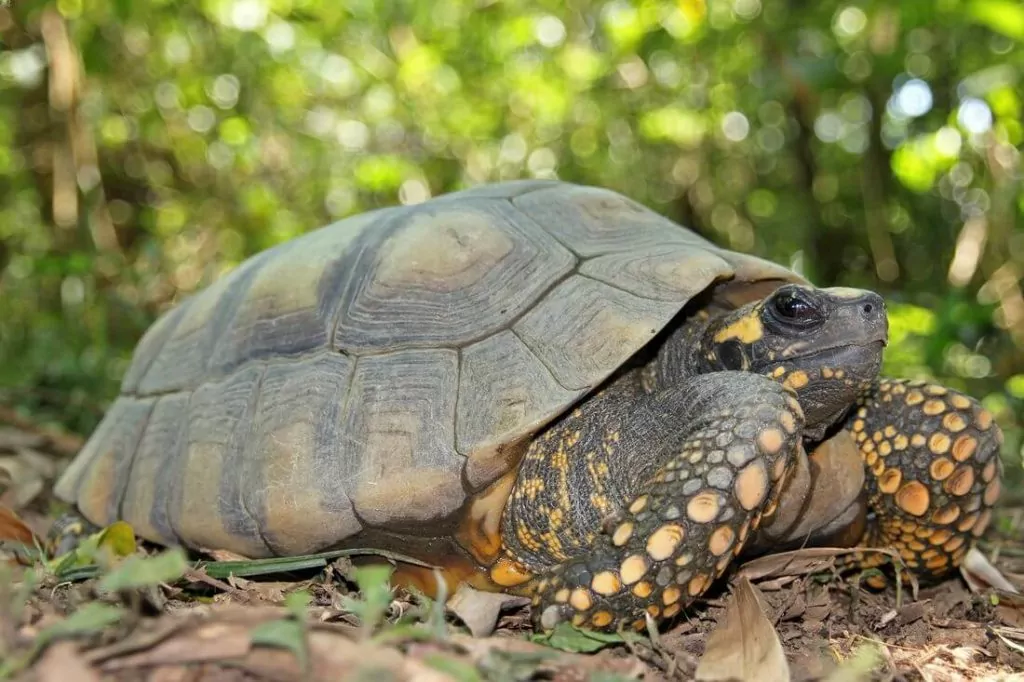
Next, add a hiding box on a cool side of the enclosure. The box should be big enough for the reptile to get in without any issues.
Some live plants and shade structures are welcome, too. If you’re keeping your tortoise outside, shade structures are a must to avoid overheating.
Temperature & Lighting
Yellow-footed tortoises prefer a temperature gradient. Most of the enclosure can be around 70 to 75 degrees Fahrenheit.
However, one area needs to be significantly warmer. Using a basking light, creating a warm spot of 85 to 90 degrees.
Expert Tip: If you’re housing the tortoise outdoors, make sure that daytime temperatures don’t exceed 90 degrees. At night, the ambient temperatures should be higher than 65 degrees to keep these creatures healthy.
For indoor homes, you’ll need to provide UV exposure. UV light is necessary for calcium synthesis. Without it, your tortoise could suffer from a litany of health problems (we go into these in detail further on in the guide).
Use a full-spectrum UVB lamp and shine it on as much of the enclosure as possible.
Humidity
These reptiles come from super humid environments. In South American rainforests, humidity levels regularly rise to 100 percent!
In order to keep your yellow-footed tortoise happy and healthy, you must do your best to provide a high-humidity environment in captivity.
Aim for humidity levels of around 80 percent. You can achieve this by regularly misting the habitat or using an automated dripper system.
An absorbent substrate will hold onto some of that water to keep things sticky.
Expert Tip: It’s also absolutely necessary for you to purchase a reliable hygrometer. These measurement devices will give you exact information about humidity levels. It’s better to use one than making rough estimates that could harm your tortoise.
Water
Remember how we said that yellow-footed tortoises like to stay near water? That applies to those living in captivity as well!
Your tortoise’s home should have a large water dish since these reptiles love to soak! The dish needs to be big enough for the tortoise to climb right in.
As for depth, aim for no more than three inches of water for adults.
Keep an eye on the water quality in the dish. Tortoises are prone to defecating in it and making a mess.
Clean the dish out daily and replenish the water regularly. This will prevent bacteria from growing and minimize the chance of your yellow-footed tortoise getting sick.
Food & Diet
These behemoths aren’t the most agile or fast creatures. As a result, they scavenge for food in the wild. They’re opportunistic omnivores that enjoy plant-based foods and the occasional high-protein snack.
A healthy diet for a yellow-footed tortoise will consist of a mix of leafy greens and fruits. Keep things interesting! Tons of variety will ensure that your tortoise is getting a healthy mix of nutrients and vitamins.
About two to four times a month, provide pinky mice or earthworms for protein. You can also offer up some commercial foods to ensure that all of their dietary needs are covered.
Here are some good foods to include in their diet:
- Dandelion greens
- Collard greens
- Zucchini
- Kale
- Romaine lettuce
- Clover
- Carrots
- Grasses
- Chicory
- Endive
- Alfalfa
- Mustard greens
- Squash
- Mango
- Mixed berries
- Melon
- Kiwi
- Pumpkin
- Plums
- Peaches
- Papaya
Potential Health Issues
Yellow-footed tortoises can suffer from a litany of health issues (especially if they don’t receive proper care). They’re susceptible to many of the same ailments as other captive reptiles face.
Issues like respiratory infections, parasites, and bacterial infections are all possible. Luckily, they are easy to avoid with the right care and living conditions.
Keeping the humidity and temperature levels stable is key to avoiding respiratory infections. This species is a bit more finicky about environmental conditions than red-footed tortoises, so keep an eye on your hygrometer and thermometer.
To prevent bacterial and parasitic problems, clean the enclosure regularly. Remove waste and sanitize surfaces about once a month.
Expert Tip: Avoid purchasing wild-caught yellow-footed tortoises. Wild specimens have a notoriously hard time adapting to life as pets.
Many suffer from fading syndrome, which causes slow premature death regardless of how good the environment is. A wild-caught yellow-footed tortoise can also harbor parasites and diseases you don’t want to spread.
Behavior & Temperament
These creatures are gentle giants and are not known to exhibit any signs of aggression. Males can sometimes use body language to communicate, but things usually stay peaceful.
Throughout the day, your yellow-footed tortoise will likely lounge around. You may see them graze on live plants in the enclosure as well.
One interesting thing about these tortoises is the noise they make. It sounds similar to a baby cooing. However, the cooing is low and raspy.
Don’t be alarmed if you hear it! Most yellow-footed tortoises will make this noise to communicate with you or others.
Handling Them
Don’t expect to get cuddly with your new tortoise. While they are docile, yellow-footed tortoises are not big on handling. Their large size also makes this a bit awkward.
If you attempt to handle them, they may try to bite you. Even if they don’t succeed, the stress they go through during handling is not worth the trouble.
Limit handling to instances where it’s absolutely necessary (such as taking them to the vet or moving them so you can work on the enclosure). Beyond that, observe your tortoise from afar and give them plenty of space to stay comfortable!
Conclusion
Yellow-footed tortoise care isn’t for everyone. With their large size and specific habitat requirements, these reptiles are best suited for an owner with a bit of experience (and room in their home).
But if you fit that description, owning one of these tortoises as a pet will be an incredibly rewarding experience. The bond you’ll be able to build throughout their long life is something that you can’t find with many other pets.
Let us know if you have any lingering questions about this species that you’d like us to answer. We’re always happy to help our readers!

